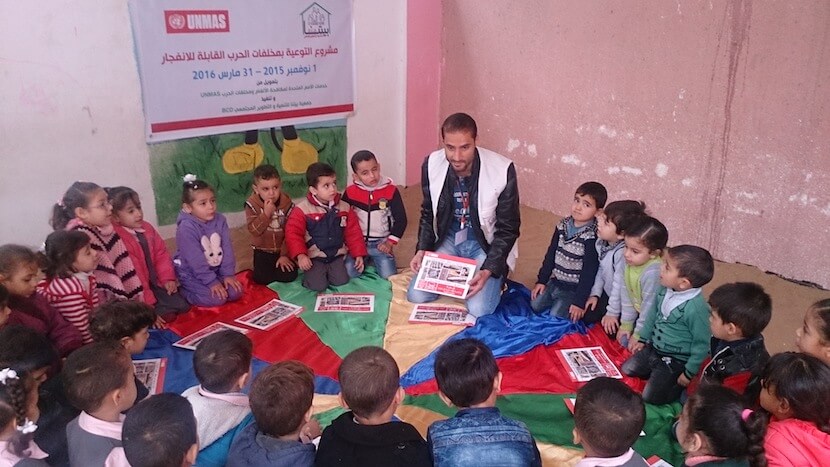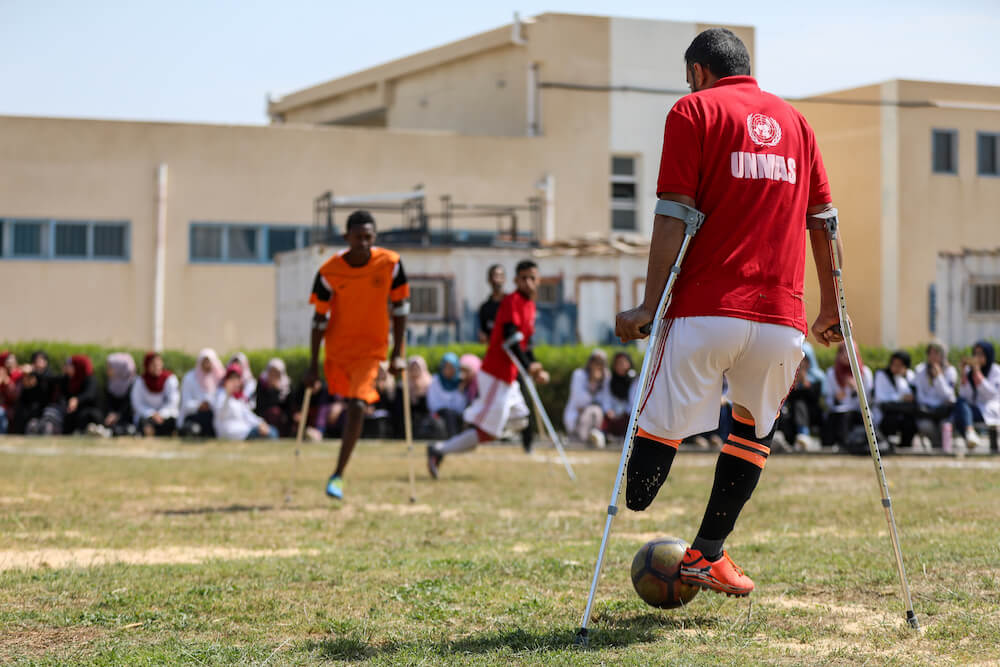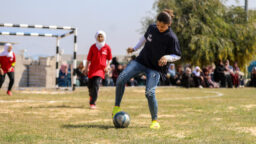Image: UNMAS
Even after a cease fire is declared and foreign troops return home, the danger is often not over for local communities. The threat of buried undetonated explosives remain.
To tackle this, the Safe Ground campaign turns minefields into playing fields, where communities can enjoy and thrive without the fear of their next step being their last.
Coordinated by the U.N. Mine Action Service (UNMAS), the campaign was launched on April 4, the International Day for Mine Awareness and Assistance in Mine Action.
That day, in the Gaza Strip, one of the world’s most contested areas, under the clear, cloudless sky stood 22 girls in soccer cleats.
With every dribble and passing across the neatly cut field, the crowd of families and neighbors erupted in cheers and applause.
But, the players and onlookers weren’t only celebrating a team’s victory or the spirit of sportsmanship, but more so the very field on which the game took place.
The crowd gathered to celebrate the playing field cleared of landmines and explosive remnants of war (ERW), which rob thousands of civilians every year of their future, at best, and lives, at worst.
One of the world’s ironies
First developed for and used in World War I, a landmine is a container of explosive material that is designed to blow up instantly upon contact with a person or vehicle; hence, the term anti-personnel mines or anti-tank mines.
“During a war, landmines, UXOs (Unexploded Ordnances) and bombs pollute the land and destroy agriculture, the ability of people and goods to move about freely,” said Tehnaz Dastoor, former UNICEF global coordinator for landmines and focal point for child soldiers.
“So children cannot attend schools or play with their friends, and women cannot gather water, sell their products at the marketplace or visit hospitals when necessary – in short, life comes to a standstill.”
One of the many paradoxes in our world is that a landmine that can leave a lasting impact on a person, whether in death or disability, is also unbelievably easy and cheap to make. Currently, while landmines are sold for as little as $3 each, it costs as much as $1,000 to remove a single landmine.
On top of all this, there are so many of them in so many places and a lot of them yet to be used. According to CARE, a major international relief agency, there are about 110 million anti-personnel mines scattered all over the world around 70 different countries and another 100 million stockpiled.
Landmines are deadly especially because they are mostly unmarked and affect local communities long after a ceasefire has been declared. In 2017, for example, at least 7,239 people were officially recorded as being killed or injured by landmines, and children made up about 33 percent of casualties, according to the 2018 report by the International Campaign to Ban Landmines.
Safe Ground’s objectives
The problem is as tragic as it can get, but the world is responding.
As a result of the United Nations’ vision of a world free from the threat of landmines and ERW, UNMAS aims to achieve three main goals: to remove landmines, which involves roads, markets, schools and hospitals; to raise risk awareness; and to assist landmine survivors to help them settle back into their communities after the explosions.
The Safe Ground campaign is unique in that it uses sports to achieve all three goals.
The campaign specifically focuses on clearing sport-oriented places, such as stadiums or fields. Once a field or a stadium is cleared of landmines, the place is designated as a Safe Ground and can be used for education or to generate financial resources for assistance to landmine survivors and their families.
Through the Safe Ground campaign, UNMAS not only removes landmines but also teaches risk awareness to local communities. They make sure the locals are aware of the most basic things, such as how to identify landmines or how to notify the authorities once a landmine-like object is spotted.
UNMAS also runs specialized sessions for children, which uses more interactive and playful methods, such as games, puppet shows, role playing, theater, music and dance, to increase their awareness of landmines. Since 2015, UNMAS has reached over 76,000 children.

And the kids are loving it, according to Bridget Forster, the program manager for the Palestine UNMAS Program.
At a recent risk education session in Rafah, Palestine, thirteen-year-old Amir said, “This knowledge is very important as we learned about risky behaviors that we see other kids do. I like the way you do this with games and songs. I think if the other kids know it is this fun, they will come to all sessions like this.”
Lastly, the Safe Ground campaign uses sports to help landmine survivors and their families thrive within their societies once again.
Many times, even in areas free from landmines, victims are often denied access to play due to their disabilities. However, on places designated as Safe Grounds, play is regarded an essential right to every man, both child and adult.
For example, in Gaza, for the International Day of Awareness and Assistance in Mine Action on April 4, on UNMAS’ Safe Ground, a soccer match was held between teams from the Palestinian Amputee Football Association.

“In post-conflict or conflict-affected countries, there are children who are injured who can’t run. There are children who have nowhere to play because the land is so contaminated by mines and other explosive remnants of war. We aim to change that,” said Forster.
“Sport and play are human rights, fostering a sustainable peace to bring communities and people closer together.”
Safe Ground also advances SDGs
In the bigger context of the United Nations’ 17 Sustainable Development Goals, the fight against landmines is deeply related to other areas, such as reducing poverty (SDG 1), reducing hunger (SDG 2), access to safe schools (SDG 4), and access to clean drinking water and power (SDG 6).
Both the presence of landmines and simply the fear of accidents severely restrict people’s mobility, affecting so many other areas of life, such as getting food from the market or getting an education from schools.
In areas contaminated by landmines and ERW, residents are constantly “at risk of death and injury as they go about their daily lives, whether they are farming, tending to animals or playing,” said Forster.
“The presence of that risk impacts on how people live their lives, where they can go and what they can do.”
With the Safe Ground campaign, however, locals have a chance to get back the universal right to freely move and play.



